More history of A-frame twin pushers
Written by Maria VanVreede Read even more about A-frame twin pushers in Bob Angel’s “Old-Timers” column that was featured in the April 2017 issue of Model Aviation.
The National Model Aviation Museum’s collection of A-frame twin pushers covers a span of more than 20 years—from 1910 to 1934. Most of the 15 models are late reproductions, but the museum has a few that are possibly originals. In addition to these aircraft, the museum’s library contains several early modeling books and magazines that discuss both the easy-to-build introductory models and the winning racers of the first part of the 20th century. Here are some highlights:
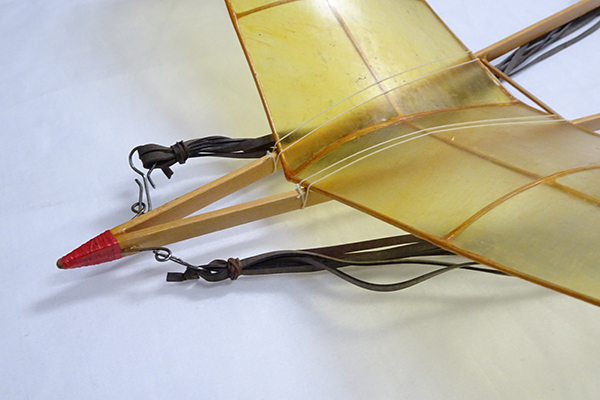
This A-frame racer built in approximately 1910 came to the museum through Jim Noonan. It is covered in a material called goldbeater’s skin. According to Paul Edward Garber’s Building & Flying Model Aircraft, published in 1928, “Another fabric employed for covering wings is goldbeater’s skin, which is very light-weight animal membrane, being the lining of part of a cow’s digestive tract. It can be purchased in sheets from model supply houses, but it is comparatively expensive.”
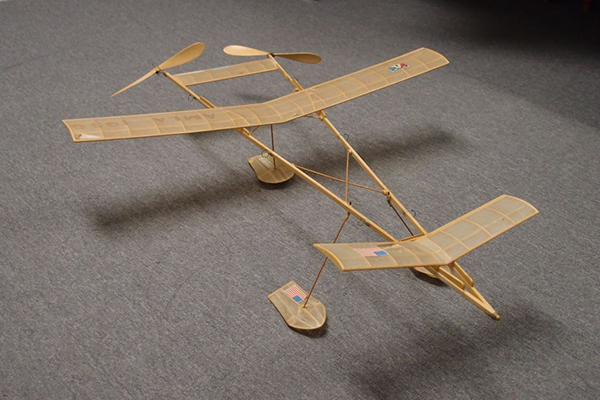
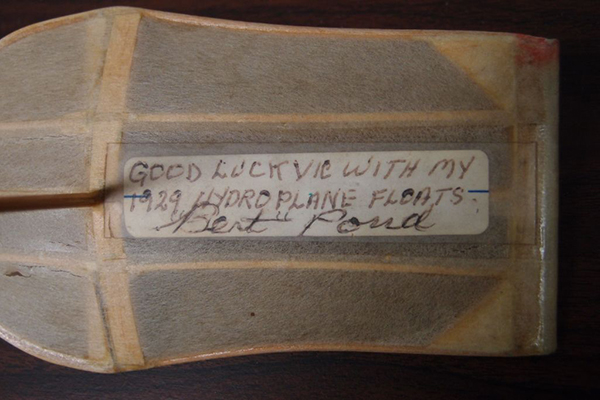
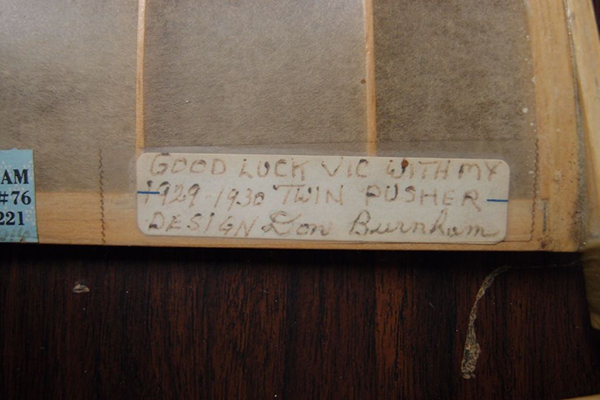
This A-frame twin pusher is a reproduction built by Vic Cunnyngham Sr. in the early 1990s. It accurately copies the A-frame pusher designed, built, and flown by Donald C. Burnham, who at the age of 14 won the Junior Division Outdoor competition at the 1929 Nats in Detroit. The floats were built from plans published by Bert Pond. (More information on this can be found in the March 2014 Model Aviation “History Preserved” column, and at this blog post.)
This A-frame twin pusher is a reproduction built by Jim Noonan of Ralph Kummer’s 1934 design. Not much else is known about it.
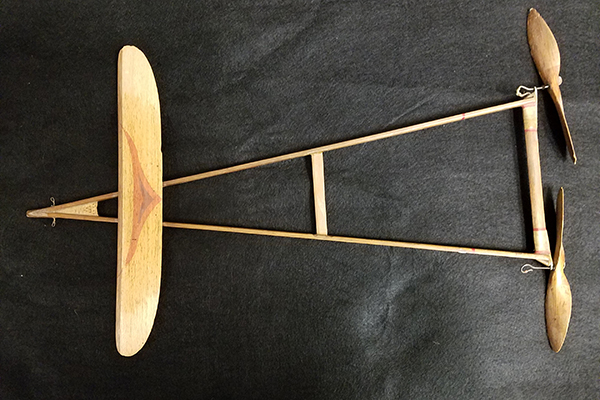
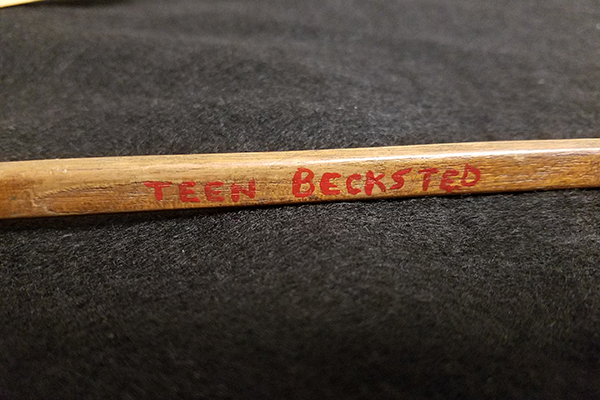
Built as a speed-racing model, this A-frame twin pusher is much smaller than the others, with only a 14-inch wingspan. Other than its wingspan—and the fact that it is an original build by Teen Becksted—little is known about this aircraft.
Was it possible to wind up both of those rubber motors at the same time? Yes, especially with a winder such as this one that is meant to wind both motors simultaneously. Some of the early modeling books are viewable online but contain little information about A-frame twin pushers. They are a great read, however, especially for understanding the ideals, goals, and vocabulary of early model aviation. Here are some of those books: • Collins, Francis A. The Boys’ Book of Model Aeroplanes. New York: The Century Company, 1910, NMAM library reference number M020.5.4. You can read this one through Google Books. • Collins, Francis A. The Second Boys’ Book of Model Aeroplanes. New York: The Century Company, 1911. By 1913, Harper’s Aircraft Book included plans for A-frame pushers. You can read that online here.
Verrill, A. Hyatt. Harper’s Aircraft Book. New York: Harper & Brothers Publishers, 1913, NMAM library reference number M020.23. Highlights of the book include: • Mann monoplane, page 42. • Cecil Peoli racer, page 49, plans on page 50. This one was really famous. A museum volunteer was building a reproduction of it as of April 2017. • Percy Pierce model, page 53, no plans. • A Japanese Flier, page 55, plans on page 57. By the late 1920s, A-frame pushers were everywhere. The following books don’t appear to be online yet, but researchers are always welcome to request copies of certain sections. Contact Maria VanVreede at [email protected] to discuss the research process.
Camm, F.J. Model Aeroplanes. New York: Funk & Wagnalls Co., 1929, NMAM library reference number M020.18. Book highlights include the following: • Page 54, “Simple Twin-Screw Monoplane,” plans on page 55. • Page 61, “Simple Twin-Screw Biplane,” plans on page 63. • Page 87, “Hydro-monoplane,” plans on page 89.
Garber, Paul Edward. Beginning and Flying Model Aircraft: A Guide for Youthful Beginners in Aeronautics. New York: The Ronald Press Company, 1928, NMAM library reference number M020.14. Highlights from this book include: • Page 126, “The Winning Model of the 1927 Tournament.” Design by Jack Lefker, write up by Joseph J. Lucas. Plans on page 130. • Page 135, “Model Flying Accessories.” It shows how to make an egg beater winder and a model-carrying box, as well as a flight box (“1st Aid [to Models] Kit”).
Allen, Elmer L. Model Airplanes: How to Build and Fly Them. New York: Frederick A. Stokes and Company, 1928, NMAM library reference number M020.30. Book highlights: • Page 19, chapter on materials, page 23 talks about buying chemicals at drug stores. • Page 66, “A twenty-four-inch hand-launched twin propeller pusher model.” Three-view drawing on page 67. • Page 84, “A thirty-six-inch twin propeller racing model,” two-page plans, pages 86-87.
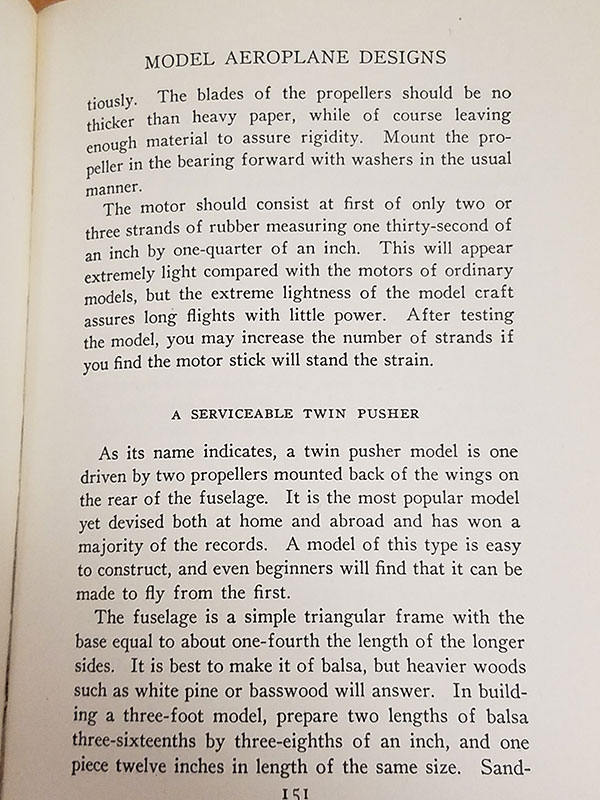
Collins, Francis A. The Boys’ Book of Model Aeroplanes. New York: D. Appleton-Century Company, Inc., 1936, NMAM library reference number M020.5.2. A notable aircraft featured in this book is: • Page 151, “A Serviceable Twin Pusher,” no plans. Do you want to try building an A-frame twin pusher of your own? AMA Plans Service has the following plans for sale:
| FLYING ACES TWIN PUSHER | 22 | FLYING ACES 11/33, UNRATH |
$4 | 24478 |
| GULL TWIN PUSHER HYDROPLANE | 28” | L. STOUT |
$4 | 12050 |
| LYNN DAVIES TWIN PUSHER (1915) | 31.5 | $7 | 11948 | |
| OUTDOOR TWIN PUSHER | 36 | COUNTRY CLUB AERO SUPPLY CO. |
$15 | 33757 |
| OUTDOOR TWIN PUSHER | 36 | MICHIGAN MODEL AIRPLANES SUPPLY CO. |
$7 | 50541 |
| TONY'S TWIN PUSHER | 17 | TONY NACCARATO |
$4 | 35966 |
| TWIN PUSHER | 36 | JUNIOR BIRDMEN OF AMERICA |
$4 | 33218 |
| TWIN PUSHER | 36 | CARL CARLSON 1926 |
$15 | 29270 |
| TWIN PUSHER | 18 | CARL CARLSON 1928 |
$4 | 29282 |
| TWIN PUSHER 1929 | 37 | JOURNAL OF INT. AEROMODELING 4/39 |
$9 | 21007 |
| TWIN PUSHER 1932 N Y C | 36 | RUGGERT |
$9 | 30591 |
| TWIN PUSHER CLASS C | 36 | JASCO 1937 YEARBOOK, CLURMAN |
$9 | 24854 |
| TWIN PUSHER CLASS D | 38 | JASCO 1935 YEARBOOK, SIMMERS |
$9 | 24854 |
| TWIN PUSHER CLASS D | 44 | BY FRANK ZAIC |
$15 | 35473 |
| TWIN PUSHER HAND LAUNCHED | 34 | JOE OTT BOOK 1932 |
$13 | 30833 |
| TWIN PUSHER HYDRO | 18 | THE OAKLAND TRIBUNE NEWSPAPER 1931 |
$7 | 29095 |
| TWIN PUSHER MIDGET | 34 | OLD TIME PLAN SERVICE 1935 |
$8 | 24540 |
| TWIN PUSHER MILE A MINUTE | 18 | JOE OTT BOOK 1932 |
$12 | 31321 |
| TWIN PUSHER MONOPLANE | 20 | SCIENTIFIC AMERICAN 1922, PEOLI |
$7 | 20997 |
| TWIN PUSHER N A A RECORD | 39 | MODEL AIRE BUILDER 8/36, KUMMER |
$9 | 24530 |
| TWIN PUSHER N A A RECORD | 38 | MODEL AIRPLANE NEWS 6/34, DUFLON |
$9 | 24531 |
| TWIN PUSHER OUTDOOR | 35 | AMERICAN BOY 2/31, HANKAMMER |
$10 | 20775 |
| TWIN PUSHER OUTDOOR | 36 | COUNTRY CLUB AERO SUPPLY CO. |
$17 | 33285 |
| TWIN PUSHER SPECIAL DURATION | 32 | ELLIOT |
$9 | 32786 |
| TWIN PUSHER WORLD RECORD | 30 | JASCO 1938 YEARBOOK, BUTLER |
$12 | 20998 |
| TWIN PUSHER WORLD RECORD | 36 | MODEL AIRPLANE NEWS 8/34, RUGGERI |
$10 | 20999 |
| YE OLDE TWIN PUSHER | 14 | BY W.C. HANNAN |
$4 | 11946 |
Would you like to immerse yourself in what Free Flight was like when A-frame twin pushers were the norm? In 2015, the museum did something called #FantasyFreeFlight to celebrate the 100th anniversary of the first National Model Aeroplane Competition, in which contestants vied for the Henry S. Villard Model Aeroplane Trophy. The fantasy team part of it is over, but there are several gems of information and some images about early contests that you can explore here: http://amablog.modelaircraft.org/amamuseum/fantasy-free-flight-1915/ A favorite part of #FantasyFreeFlight was this poem about a common modeling occurrence. It sounds like something that could happen today! http://amablog.modelaircraft.org/amamuseum/2015/07/09/fantasyfreeflight-a-1915-aeromodeling-conversation -Maria VanVreede [email protected]










2 comments
rubber powered speed plane of Teen Becksted
Julius Unrath's Flying Aces Twin Pusher
Add new comment